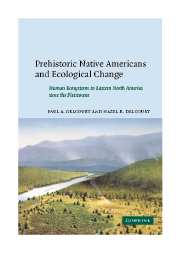 Prehistoric Native Americans and Ecological Change
Prehistoric Native Americans and Ecological Change PART III - APPLICATION AND SYNTHESIS
Published online by Cambridge University Press: 30 October 2009
Summary
OVERVIEW
In Chapter 9 we summarize the implications of viewing Holocene human ecosystems as adaptive and panarchical in nature. In the United States, land management plans have been predicated on the premise that prehistoric humans had no lasting influence on native ecosystems. Well-documented paleoecological and archaeological studies clearly indicate that this assumption is not warranted. Since their arrival on the North American continent, Native Americans were part of an evolving set of human ecosystems. Through time, increasing complexity of the human–ecosystem panarchy arose from both cultural and ecological interactions. These interactions were effective at all levels of biological organization, from genetic, to population, community, landscape, and regional levels (Figure 3.4). No single arbitrary time line is appropriate as a focus for land management, since ecosystems have been evolving continuously in response to late-Quaternary environmental change and human activities. Scientific studies combining paleoecological and archaeological techniques provide a context for the trajectory of change on a local, regional, and continent-wide basis. Understanding this context is essential for guiding future efforts to manage biological diversity.
- Type
- Chapter
- Information
- Prehistoric Native Americans and Ecological ChangeHuman Ecosystems in Eastern North America since the Pleistocene, pp. 161Publisher: Cambridge University PressPrint publication year: 2004


